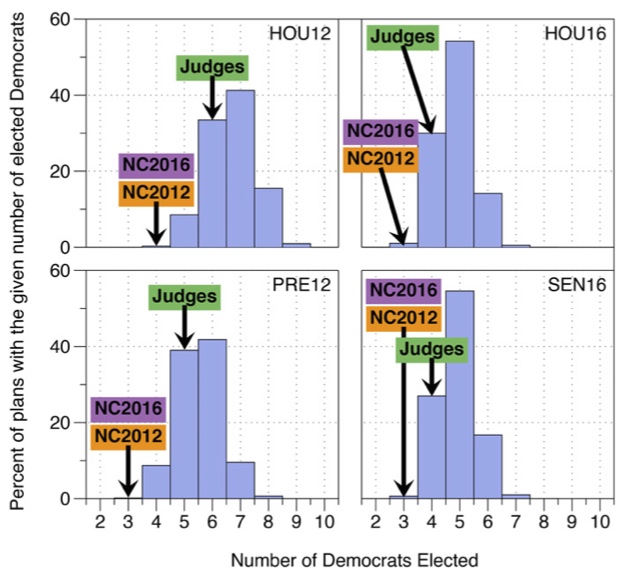- House Bill 495 (“Redistricting Criteria for 2021”) has several good elements that legislators should include in any redistricting plan they pass
- But the bill falls short of ideal in how it mandates the use of political data in the redistricting process
- It also fails to protect counties from being unnecessarily split and appears to define “community of interest” to advantage Democrats
The General Assembly will not deal with redistricting until the fall due to a delay in receiving necessary data from the Census Bureau. But it has not stopped legislators from filing several redistricting-related bills this spring. One of those bills includes a good set of redistricting standards but fails due to several problematic proposals it contains.
Redistricting Bill Sets Some Good Standards …
One of the more fully thought out redistricting bills is House Bill 495 (H.B. 495, “Redistricting Criteria for 2021”), sponsored by Reps. Pricey Harrison (D-Guilford), Robert T. Reives, II (D-Chatham, Durham), Amos L. Quick, III (D-Guilford), and Grier Martin (D-Wake). While it did not advance out of committee, it offers some clues about the arguments Democratic legislators will back when the General Assembly takes up redistricting in the fall.
H.B. 495 has several elements that overlap with the best practices, in addition to those mandated by current law, that I spelled out in an article last February. They include not using election results data when drawing individual districts.
One improvement the bill would make over current practice would be requiring that the population deviation for Congressional districts must be zero “unless a higher deviation is necessary to achieve or optimize a compelling State interest associated with the baseline criteria.” That provision would limit the practice of splitting precincts to achieve equal population between congressional districts, because one of the baseline standards is that “all districts shall minimize the number of split precincts and municipalities.” The exactly equal population standard is silly since the populations of those districts would already deviate from the census population by the time districts are drawn.
H.B. 495 would also specify that “reasonable efforts shall be made” to make districts compact and that legislators should not draw districts to advantage or disadvantage any candidate.
… But Otherwise Goes Off the Rails by Mandating “Outlier Analysis” with Political Data
For all its good points, H.B. 495 is a bad redistricting bill.
The bill’s biggest problem is that, rather than banning the use of political data in the redistricting process, it would mandate its use through an “outlier analysis” similar to that conducted under the direction of Duke University math professor Jonathan Mattingly. Lawyers used Mattingly’s work in lawsuits that overturned state legislative and congressional districts in 2019.
Outlier analysis is basically having computers draw tens of thousands of random district maps within a set of parameters (such as all districts having to be contiguous) to see what the most common expected aggregate outcomes by party are, based on analysis of prior election results. The bill would ban any plan that does not fit within an acceptable range of the most common result. It would require that any congressional district plan not deviate more than one seat from the most common seat distribution. For example, if the most common congressional seat distribution was 9-5 in favor of Republicans, only plans in which the expected outcome of congressional elections would be between 10-4 and 8-6 in favor of Republicans would be allowed. The bill would allow a deviation of two seats from the most common result for state Senate plans and three seats for state House plans.
Of course, computers cannot draw districts without someone programming them with what to do and analyzing their output. Who would conduct that analysis? The bill would require the General Assembly to hire an outside consultant. That consultant would have enormous power in the redistricting process, since that person would set the criteria used for weighing how the plans created by the computers are compliant with redistricting criteria.
Mattingly himself admitted that there is “no consensus probability distribution to select compliant redistricting plans” (page 31), meaning that whoever is selected to conduct the analysis would have leeway to affect the outcome of the analysis. That problem is seen in the distributions of congressional districts in a study conducted by Mattingly and others. The distributions they used showed that districts drawn by the General Assembly in 2012 and 2016 were partisan outliers that favored Republicans (see Figure 1, taken from their research paper). On the other hand, the most common outcomes of their method consistently favored Democrats when compared with a nonpartisan map drawn by a bipartisan group of former North Carolina judges in 2016.

Results of analysis which found that congressional redistricting plans drawn by the General Assembly (NC2012, NC2016) were outliers compared with sets of 66,544 district maps created by Jonathan Mattingly and colleagues using election data from 2012 and 2016 US House, 2012 Presidential, and 2016 Senate elections. The most common partisan composition using their methodology (the highest bar in each chart) consistently favored Democrats more than a nonpartisan plan created by a bipartisan group of judges (Judges). The figure is from Herschlag et al., Quantifying Gerrymandering in North Carolina, Statistics and Public Policy, 7:1, 30-38, DOI: 10.1080/2330443X.2020.1796400.
That is not to say that Mattingly and his team intentionally manipulated the analysis; there is no evidence of that. It demonstrates the power over the redistricting process that a third party hired to conduct outlier analysis would have, however. The idea of handing that much power over to a third party creates two problems:
- There is little chance that Democrats and Republicans would agree on who should have that power.
- The outlier analysis section of the bill may violate the North Carolina Constitution’s requirement that the General Assembly draw districts, since it would result in handing off a substantial part of the process to a third party whose analysis would limit what districts the legislature could draw.
The outlier analysis portion of the bill alone makes it a bad redistricting bill.
Two More Problems with the Bill
There are two other problems with the bill.
First, it would require that legislators “minimize the number of split precincts and municipalities,” but it does not similarly mention counties. Since the North Carolina Constitution already requires minimizing the number of split counties, the omission here would open the door for legislators to pick apart counties when drawing congressional districts. If the goal is to maintain political boundaries, counties should join municipalities and precincts on that list.
The bill’s treatment of communities of interest is also problematic. Part of the problem is that “community of interest” is a notoriously vague concept. The bill’s definition does little to clarify it, however, defining it as “people that share common social, cultural, and economic interests.” There is, however, one concrete community of interest in the bill — college campuses and “off-site housing near the campus” are declared a community of interest. Since Democrats traditionally do well on college campuses, their inclusion as the only well-defined community of interest is suspicious.
While H.B. 495 has some good elements, it is far too flawed to be considered as a viable set of rules for the upcoming round of redistricting.


